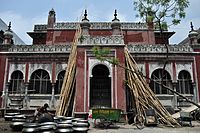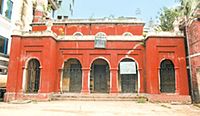- Northbrook Hall
-
Coordinates: 23°42′N 90°24′E / 23.7°N 90.4°ENorthbrook Hall also known as “Lalkuthi” or red house because of its deep red colour, was originally built as a town hall during the British period. It is situated at Farashgonj road in Old Dhaka, on the north bank of the Buriganga River, Bangladesh.
Contents
History
In 1874 Indian Governor Thomas George Baring (22 January 1826 – 15 November 1904), Lord Northbrook, who was the Viceroy of India between 1872 and 1876, came to visit Dhaka. So, to make his visit memorable, Raja Rai Bahadur along with some eminent Zamidars and affluent citizens of Dhaka donated 10 thousand and 5 thousand taka each to build this Town Hall in 1879.Abhay Chandra Das was the secretary of this committee. In 1880, the Commissioner of Dhaka inaugurated it. Moreover, the personal band of Nawab Abdul Ghani was brought to entertain the commissioner and the guests on the day of inauguration.
Later, on 8 february, 1882 a public library was added on the south-east side of the Hall. It was named “Northbrook Public Library” which became highly renowned for its rich literary collection. However, many books were ruined during the 1971 Liberation War. So, to re-establish the library, primarily the Maharaja of Tripura donated 1000tk, the zamidar of Baliati Brojendro Kumar Roy 1000tk, Queen Shornomoi 700tk, Kalikhrishno 500tk and Bishaishori Devi donated 500tk.On 1887, the library was opened with only 1000 books which were procured mainly from UK.
A clubhouse was also added to the south-side and called Johnson Hall.
In 1950, the Northbrook Hall was used as telegram office, later as Central Women’s’ Collage. Afterwards, since this very day this building is a property of Dhaka Municipality Corporation.[1][2]
Architecture
Northbrook Hall is an Indo-Saracen building, which is a fusion of Mughal architecture blended with European Renaissance architectural styles. The semi-circular horseshoe arches contains the main entrance which is on the north side. The four octagonal minarets on the north side along with pinnacles and ornamental parapet demonstrate the Muslim and Mughal feature. Moreover, the windows, doors, and the walls were ornate using the European style. But the domes at the top of the building were ornate using Muslim style. The red colour of the grand monumental building with graded roofs, pinnacles and parapets gives a magnificent European view and as well as presents a marvellous view from the riverfront.[3]
Current situation
The Buriganga River could be seen from the Northbrook hall when it was built but unfortunately by 1930, the riverfront and the river could not be seen any more. The area too lost its importance, beauty and residential character, and was transformed into a commercial area.
In 1998, a government education office was built by the side of Northbrook Hall, part of which is now used by a decorator, and a pentagram fountain in front of the north entrance now completely obscures the view. Afterwards, new structures such as assembly halls and community centres were built in the same premises and now it is surrounded from all sides.
Gallery
-
Nb1.JPG
Pentagram fountain in front of the main entrance on the north side of Northbrook Hall
References
Bibliography
- Ahmed, Dr.N; John Sanday (1984). Discover The Monuments Of Bangladesh. University Press Limited. ISBN 984-05-105-92.
- Mamun, M. (June 1984). Dhaka Smriti Bismritir Nagari. Ananya. ISBN 984-412-104-3.
External links
Categories:- Buildings and structures in Dhaka
-
Wikimedia Foundation. 2010.





